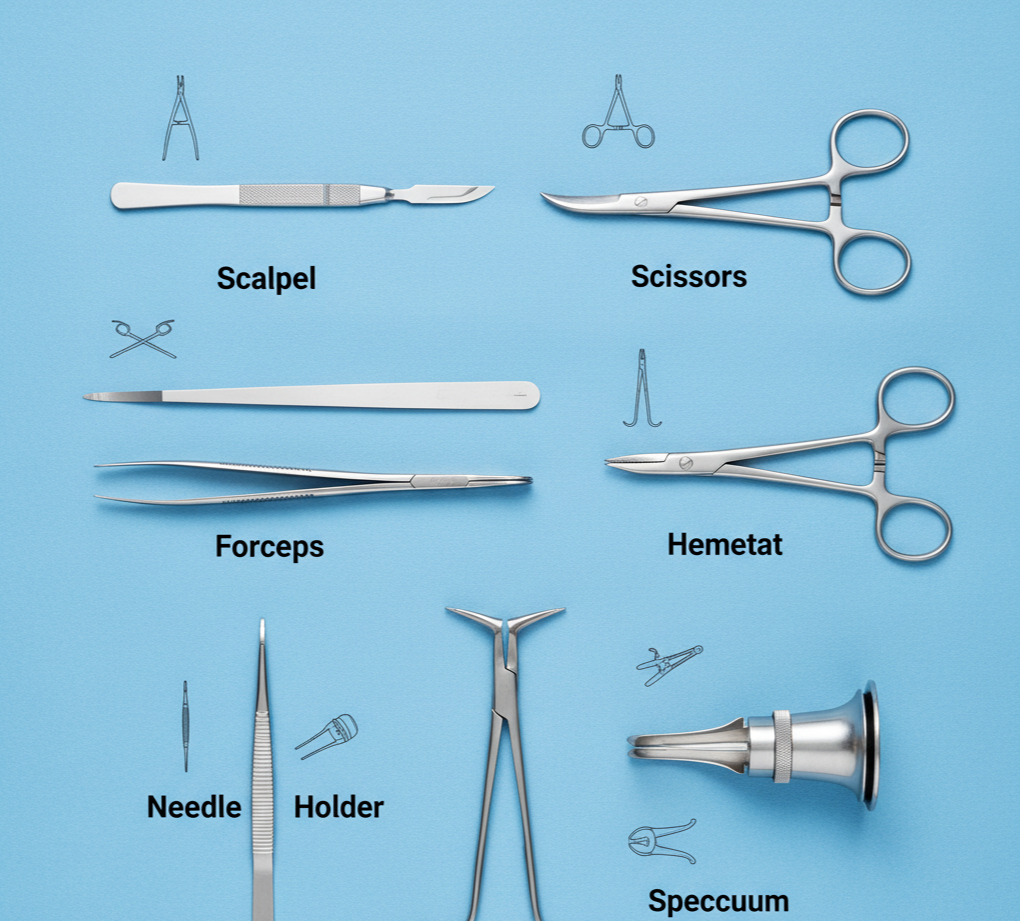In modern healthcare, surgical success depends not only on the skills of the surgeon but also on the quality of surgical instruments. For medical students, healthcare professionals, and buyers, understanding surgical instruments name and picture is essential. This guide provides a detailed overview of common surgical instruments, their uses, and why images with names are important for learning and purchasing.
Why Surgical Instruments Name and Picture Matter
Knowing instruments by name and picture is crucial in medical practice and education.
- Medical Students – Learn identification quickly with visual reference.
- Surgeons & Nurses – Ensure accurate tool selection during procedures.
- Buyers & Distributors – Prevent confusion while ordering instruments.
- Hospitals & Clinics – Streamline inventory and supply management.
Categories of Surgical Instruments with Names and Pictures
Surgical instruments are categorized by their function. Below are the main groups:
Cutting and Dissecting Instruments
These tools are used for making incisions and cutting tissues.
- Scalpel – A sharp blade for precise cuts.
(Picture: A sterile scalpel on surgical cloth) - Surgical Scissors – Straight or curved scissors for tissue and sutures.
(Picture: Pair of stainless steel curved scissors) - Bone Cutter – Used in orthopedic surgeries to cut bones.
(Picture: Heavy-duty stainless bone cutter)
Grasping and Holding Instruments
These are designed to hold tissues and materials securely.
- Forceps – Available in toothed and smooth types for gripping.
(Picture: Toothed forceps with serrated tips) - Needle Holder – Holds surgical needles during suturing.
(Picture: Needle holder with ratchet lock) - Towel Clamp – Used to hold drapes and tissues.
(Picture: Sterile towel clamp)
Clamping and Occluding Instruments
These control bleeding by clamping vessels or tissues.
- Hemostats – Locking forceps to stop blood flow.
(Picture: Curved hemostat with serrated jaws) - Artery Forceps – Similar to hemostats, used in vascular surgery.
(Picture: Long artery forceps) - Bulldog Clamp – Small clamp for delicate vascular procedures.
(Picture: Bulldog clamp with spring action)
Retracting and Exposing Instruments
These keep tissue away for better visibility during surgery.
- Retractors – Handheld or self-retaining to expose surgical areas.
(Picture: Surgical retractor with flat blades) - Speculum – Used in gynecology and ENT surgeries.
(Picture: Stainless steel vaginal speculum) - Skin Hooks – Used to retract delicate skin layers.
(Picture: Double-prong skin hook)
Suturing and Stapling Instruments
Used for closing wounds after surgery.
- Needle Holder – Guides surgical needles.
(Picture: Mayo-Hegar needle holder) - Surgical Stapler – For fast incision closure.
(Picture: Disposable surgical stapler) - Suture Scissors – Designed for cutting sutures cleanly.
(Picture: Lister suture scissors)
Specialized Surgical Instruments
Some fields use specific instruments:
Dental Surgical Instruments Name and Picture
- Extraction Forceps (Picture: Tooth extraction forceps)
- Elevators (Picture: Dental elevator with stainless handle)
- Scalers (Picture: Periodontal scaler)
ENT Surgical Instruments Name and Picture
- Ear Speculum (Picture: Black ENT ear speculum)
- Nasal Speculum (Picture: Stainless nasal speculum)
- Laryngoscope (Picture: Fiber-optic laryngoscope)
Orthopedic Surgical Instruments Name and Picture
- Bone Drill (Picture: Manual bone drill)
- Plates and Screws (Picture: Orthopedic implant set)
- Orthopedic Saw (Picture: Oscillating surgical saw)
Importance of Sterile Instruments with Names and Pictures
Using sterile surgical instruments with clear names and pictures provides:
- Accurate training for medical students.
- Reliable references for procurement.
- Safer surgeries with correct instrument use.
- Easy cataloging for distributors and buyers.
Tips for Maintaining Surgical Instruments
- Clean immediately after use.
- Sterilize through autoclaving or chemical methods.
- Store in a sterile, dry environment.
- Regularly inspect for wear and tear.
Where to Find Surgical Instruments Name and Picture
1. Manufacturer Websites
Provide detailed catalogs with images and names.
2. Medical Marketplaces
E-commerce platforms like Alibaba, Amazon, or specialized medical sites.
3. Professional Catalogs
Exporters and suppliers like Professional Enterprises offer detailed catalogs with names and product codes.
Why Choose Professional Enterprises
At Professional Enterprises, we provide:
- High-quality surgical instruments with names and pictures.
- Stainless steel tools meeting international standards.
- Catalogs for easy selection and ordering.
- Customized branding and private labeling.
- Worldwide export at competitive prices.
FAQs About Surgical Instruments Name and Picture
Q1: Why are pictures important with surgical instrument names?
They prevent confusion and ensure correct identification.
Q2: Can I get a full catalog with names and pictures?
Yes, most exporters, including Professional Enterprises, provide digital and printed catalogs.
Q3: Which instruments are essential in general surgery?
Scalpels, scissors, forceps, clamps, and retractors.
Q4: Do pictures of surgical instruments differ by region?
The design may vary slightly, but international names are widely recognized.
Conclusion
Understanding surgical instruments name and picture is essential for medical learning, procurement, and safe practice. From scalpels to retractors, each tool plays a vital role in surgery. With the right supplier, hospitals and distributors can access high-quality instruments with proper names and images for accurate identification.

